Biofeedback Headband For Bruxism
25th Jul 2021
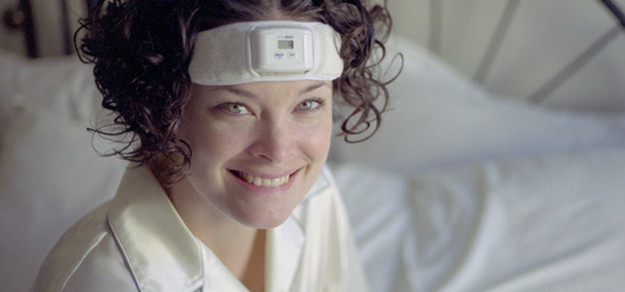
Biofeedback therapy uses electronic monitoring tools which help listen to your body in a new way. This information can then be used to improve a health condition or physical performance. As Mayo Clinic explains, "biofeedback gives you the ability to practice new ways to control your body". The biofeedback headband for bruxism capitalizes on this concept, offering nighttime biofeedback in the comfort of your own home for those struggling with nighttime teeth clenching, teeth grinding, or TMJ disorder. This can relieve many of the painful symptoms such as sore jaw, facial pain, headaches, worn teeth, and more.
While it's a relatively new option, this medical device has been approved by the U.S. Food and Drug Administration (FDA). The headband has also shown its effectiveness in multiple clinical trials. A biofeedback headband may be the solution for your bruxism and/or TMJ pain. So, how does it work? What are the pros and cons of this form of treatment? And, what are treatment alternatives?

What Is a Biofeedback Headband?
The biofeedback headband is a simple, user-friendly medical device. When you wear it around your forehead during the night, it monitors your movements for signs that you're going to begin grinding or clenching. If these movements occur, it delivers the appropriate nighttime biofeedback to put a stop to grinding and clenching before they begin. "Nighttime biofeedback helps the majority of people to reduce or eliminate the addictive clenching habit that is causing painful TMJ disorder symptoms in the first place," says Lee Weinstein, an MIT electrical engineer and the designer of the SleepGuard biofeedback headband.
Using this biofeedback device may help more than just bruxism and TMJ disorders. SleepGuard claims that neurologists recommend the device for the treatment of headaches and migraines as well. Meanwhile, others have reported that it has provided relief from tinnitus, neck pain, jaw pain, and other health conditions.

How Does a Biofeedback Headband for Bruxism Work?
As SleepGuard explains, the biofeedback headband uses electromyography (EMG) to track muscle movement. Two silicone pads in the headband rest against your temples. From there, they monitor activity in the jaw muscles to predict when teeth grinding or jaw clenching is likely to occur.
When you start to grind or clench, the module at the center of the headband emits a RelaxTone. This is a soft noise which alerts you to stop grinding/clenching. It starts softly and grows louder until you stop bruxing. As soon as you stop the behavior, the sound stops. The idea is to condition yourself to react to the sound automatically and subconsciously. SleepGuard compares it to the way an experienced driver reacts without thought when the brake lights of the car traveling in front of them flash. The lesson is so deeply entrenched that their body is already responding before they've processed seeing the brake light.
Nighttime biofeedback begins with daytime training. Start by wearing the headband for two-minute practice sessions during the day. Intentionally clench or grind your teeth to trigger the biofeedback sound. When it sounds, relax your jaw, and think about how it feels. Picture yourself instinctively relaxing and going back to sleep so that you can wake up refreshed. With practice, this could be your reality. Most people will only need a few days to establish the necessary connection in their subconscious.
Ideally, as soon as you begin to clench, the RelaxTone will sound. Hearing it will remind you to relax your jaw, and the sound will turn off without waking you or your partner.
The SleepGuard biofeedback headband keeps track of how many times you clench your teeth and for how long during episodes of nighttime bruxism. That means that you can track your progress, so you can see for yourself whether the device is working for you. The device comes with standard settings that seem to work well for most patients, but it is customizable. If you need more or less sensitivity, you can adjust the clench strength that triggers the tone. If you believe you need a louder alarm, you can turn up the volume.

What Are the Pros and Cons of a Biofeedback Headband for Bruxism?
The SleepGuard biofeedback headband has some serious advantages. As a 2010 clinical trial demonstrated, about 75% of people are able to decrease their nightly clenching substantially through continued use of the SleepGuard biofeedback headband. It's fairly simple to use. It's also drug-free and non-invasive, so the concern about nasty side effects is minimal.
Of course, one size does not fit all, so no one treatment works for everyone. After all, an audible alarm at night can be disruptive. If someone triggers the RelaxTone frequently, it may leave either the user, their sleeping partner, or both of them incredibly fatigued from interrupted sleep.
What Does a Biofeedback Headband Cost?
The price tag for a biofeedback headband varies depending on what item you select and where you purchase it. Typically, you can expect a biofeedback headband to cost between $200 and $400, but some companies offer a rental option for those looking to try out the device with less commitment. One popular choice is the SleepGuard biofeedback headband, formerly known as Holistic Technologies. The company offers a 30-day money-back guarantee so that people can see if biofeedback works for them.
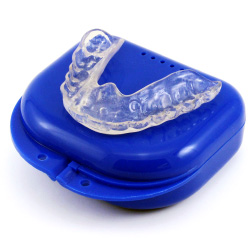
- Most Popular
- Hard Outside, Soft Inside
- 2MM Thick
- Moderate / Heavy
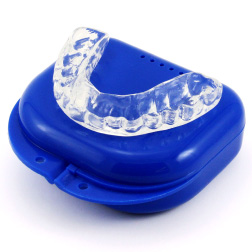
- Most Durable
- Hard Materials
- 1.5MM Thick
- Heavy / Severe
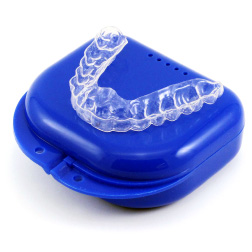
- For Day Time Use
- Thin, Barely Visible
- 1MM Thick
- Light / Moderate
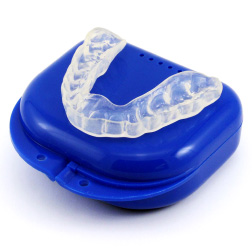
- For Clenching
- Flexible & Soft
- 1.5MM Thick
- Light / Moderate
What Are Some Other Treatments for Bruxism?
When it comes to treating bruxism, you have more treatment options:
- Custom Mouth Guard: The first thing health care professionals tend to recommend for bruxism is a custom mouth guard. Teeth grinding is a tough foe that can endanger your smile and your temporomandibular joint. Mouth guards offer an effective defense. As the Cleveland Clinic indicates, these devices, which are also called night guards or oral splints, "can protect your teeth, joints, and help ease the pain".
- Botox: Botox isn't just used for cosmetic purposes. As Colgate reports, injecting the masseter muscles (which are responsible for chewing) can help to relax the muscles and relieve pain. Using botox for teeth grinding results in about three to six months of relief before follow-up is necessary.
- Relaxation Techniques: Stress is one of the most common causes of bruxism and TMJ. As such, treating this underlying issue can help reduce grinding habits. Many bruxers have found success in stress-relief techniques such as yoga or meditation.
- Supplements: Bruxism can also be a result of certain vitamin deficiencies. Magnesium, calcium, and vitamins B and C deficiencies can trigger teeth grinding. Restoring normal levels of these minerals through diet and supplements can put an end to the nasty habit.
Related Articles:
Biofeedback Headband For Bruxers
The biofeedback headband for bruxism offers an interesting option for people who battle bruxism. Though it is a relatively new device, biofeedback has been studied as a treatment for bruxism for many years. Fortunately, there are various other ways to treat bruxism as well. When you struggle with teeth grinding and jaw clenching, the trick is finding the method or combination of methods that work for you. If a custom mouth guard is part of your strategy, be sure to check out the selection at Pro Teeth Guard. We make our night guards in a professional dental lab, and every night guard is guaranteed to fit comfortably with our 110% money-back guarantee.
References:
- Cleveland Clinic Writing Staff. (2021). Should You Use a Dental Mouthguard for Your Jaw Pain? Health Essentials from Cleveland Clinic. https://health.clevelandclinic.org/should-you-use-a-dental-mouthguard-for-your-jaw-pain/
- Colgate Writing Staff. (n.d.). Using Botox as a Treatment for Grinding Teeth. Colgate. https://www.colgate.com/en-us/oral-health/bruxism/botox-for-bruxism-learn-whats-right-for-you
- Mayo Clinic Staff. (2021 Biofeedback. Mayo Clinic. https://www.mayoclinic.org/tests-procedures/biofeedback/about/pac-20384664
- SleepGuard Writing Staff. (n.d.). How Well it Works. SleepGuard. https://mysleepguard.com/solution/how-it-works/proof-it-works/#clinical-trial
- SleepGuard Writing Staff. (n.d.). The Science of How SleepGuard Biofeedback Works. SleepGuard. https://mysleepguard.com/solution/how-it-works/biofeedback-principal/
- Weinstein, L. (2013). Wearable Nighttime Biofeedback Brings New Hope for TMJ Disorder Sufferers Without Drugs. Cision PRWeb. https://www.prweb.com/releases/2013/1/prweb10290195.htm

- Most Popular
- Hard Outside, Soft Inside
- 2MM Thick
- Moderate / Heavy

- Most Durable
- Hard Materials
- 1.5MM Thick
- Heavy / Severe

- For Day Time Use
- Thin, Barely Visible
- 1MM Thick
- Light / Moderate

- For Clenching
- Flexible & Soft
- 1.5MM Thick
- Light / Moderate

